Transform thrift store finds into powerful tools for managing anxiety through seven therapeutic DIY projects. You'll create calming sensory jars from vintage mason jars, design meditation stations with old frames, and craft wall art from soft textiles. Turn hardcover books into mindful zen gardens, practice emotional release through furniture painting, arrange ceramic bowl mosaics, and build personal anxiety relief boxes. Each project combines creative expression with mindfulness, helping you stay grounded while giving forgotten items new purpose. These hands-on transformations offer more than just crafts – they're stepping stones to emotional well-being and inner peace.
Mindful Mason Jar Makeovers
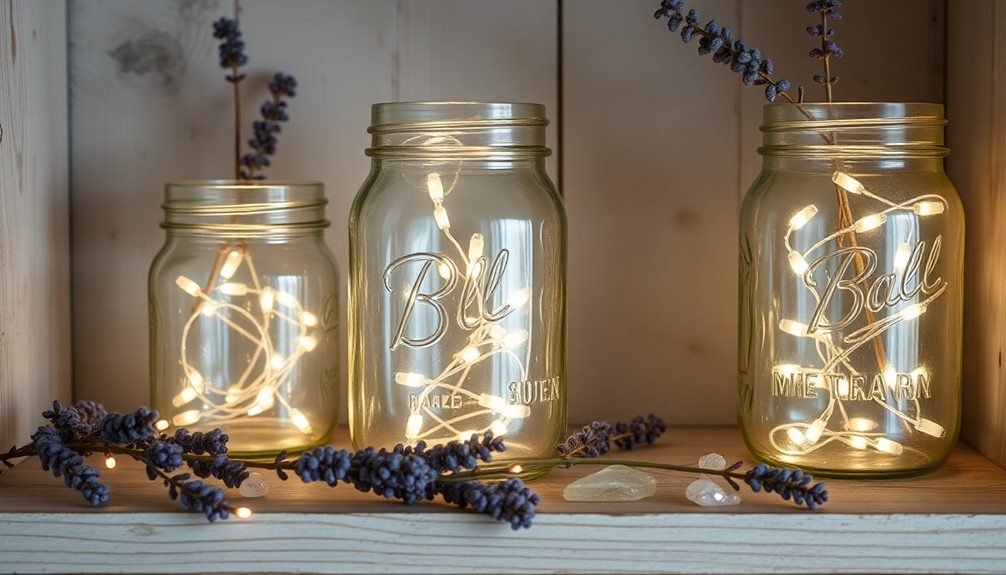
Mason jars from out of thrift stores offer endless creative possibilities for mindful crafting and organization. You'll find these versatile vessels for mere pennies, often with charming vintage details that modern reproductions lack. By transforming these forgotten treasures, you're not only saving money but also engaging in an eco-conscious, therapeutic activity.
Start by thoroughly cleaning your mason jar finds with warm, soapy water and removing any stubborn labels with vinegar or oil. You can create calming sensory jars by filling them with water, glycerin, and glitter – perfect for meditation or anxiety relief. Transform them into mindfulness timers by adding colored sand, or craft them into mood-lifting terrariums with small succulents and colored stones.
For organization that soothes a busy mind, paint your jars with chalk paint and label them clearly. You'll find peace in sorting art supplies, bathroom essentials, or pantry items into these coordinated containers.
Add battery-operated fairy lights to create gentle ambient lighting, or use them as vases for fresh flowers to bring nature indoors. Each jar becomes a mini project that helps focus your thoughts and reduce stress.
Vintage Frame Meditation Stations
Those neglected vintage frames gathering dust in thrift stores can become the foundation for your personal meditation station. Select frames with sturdy construction and interesting architectural details, as they'll serve as both focal points and boundaries for your mindfulness practice. Look for pieces at least 16×20 inches to guarantee adequate space for your meditation elements.
Transform your frame by sanding rough edges and applying a calming paint color that resonates with your sense of peace – soft blues, gentle greens, or warm neutrals work well. Install a backing board of cork, fabric-covered foam core, or painted plywood to create your meditation canvas.
You'll want to attach small hooks or clips to display meaningful items, mantras, or intention cards. Add elements that ground your practice: a small shelf for holding crystals, a clip for hanging mala beads, or wire strands for interchangeable inspiration cards.
Include a battery-operated timer or small chime, and consider adding LED string lights for gentle illumination. Position your completed station at eye level when seated in your meditation space, creating a dedicated zone that signals your mind it's time to pause and reflect.
Calming Textile Wall Art
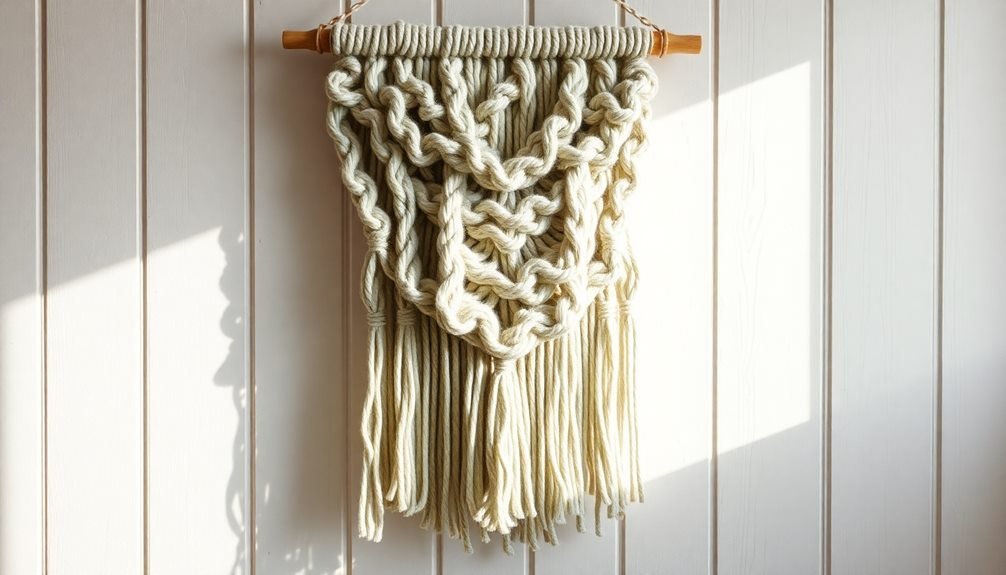
Soft textiles from thrift stores offer another pathway to creating mindful spaces beyond meditation stations.
You'll find abundant options like vintage scarves, woven tapestries, and delicate lace pieces that can transform into soothing wall art. These preloved fabrics often carry rich textures and gentle patterns that naturally draw your eye and calm your mind.
Transform your thrift store textiles into therapeutic wall displays by following these steps:
- Select pieces with calming color palettes – focus on soft blues, gentle greens, and warm neutrals that promote relaxation and help reduce anxiety.
- Layer different textures strategically – combine smooth silks with nubby weaves or delicate crochet work to create visual interest that encourages mindful observation.
- Frame your textiles thoughtfully – use embroidery hoops, floating frames, or fabric-wrapped canvas to showcase each piece's unique characteristics.
Old Book Sensory Gardens
Yellowed pages and weathered book covers can find new life as unique sensory gardens that engage both mind and spirit.
You'll discover that transforming old hardcover books into miniature zen gardens creates a powerful tool for managing anxiety and restoring calm.
Start by removing the book's pages, leaving a hollow center within the hardcover. Fill this space with fine sand, creating a base for your sensory experience.
You can add smooth river stones, tiny air plants, or delicate moss to create different textures and focal points. Consider incorporating small crystals or sea glass for visual interest and therapeutic touch points.
The book's cover serves as a natural frame, making your garden portable and contained.
You'll want to seal the inner surfaces with craft adhesive to prevent sand leakage. Using a small rake or wooden stick, you can draw patterns in the sand – circles, waves, or straight lines – whenever you need to ground yourself.
This mindful activity helps reduce stress while giving discarded books renewed purpose.
For added sensory benefits, you might include dried lavender sprigs or cedar chips, allowing gentle scents to enhance your calming ritual.
Wooden Furniture Paint Therapy
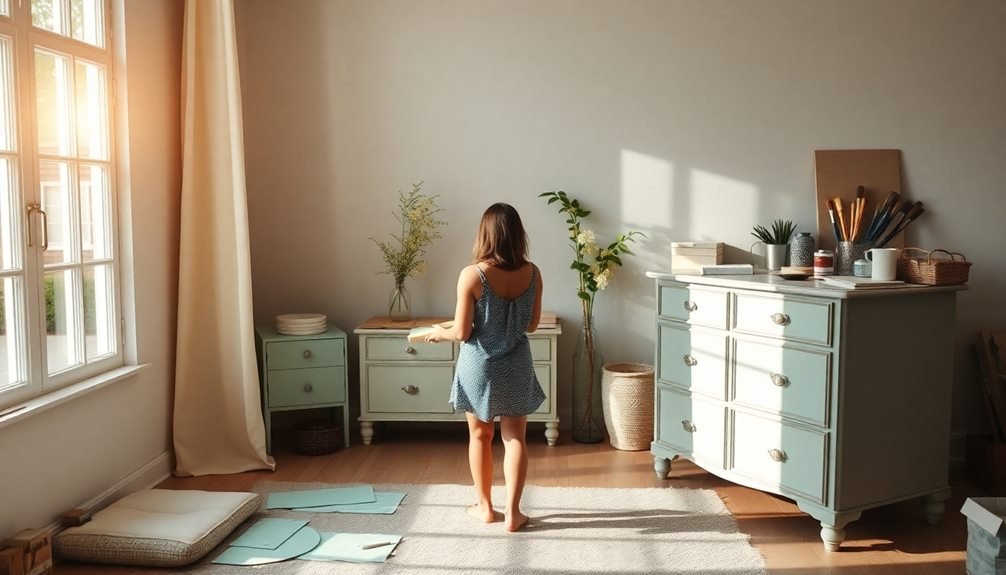
When you're feeling overwhelmed, the rhythmic motion of sanding old thrift store furniture can help channel your nervous energy into something productive.
You'll find that choosing and applying fresh paint colors to your wooden finds creates a powerful metaphor for transforming your own mindset.
Sanding Away Nervous Energy
Transforming old wooden furniture through sanding can be a powerful outlet for anxiety and stress. The repetitive motion of working sandpaper against wood grain creates a meditative rhythm that helps quiet racing thoughts. As you feel the rough surface becoming smoother beneath your hands, you'll notice your tension melting away with each stroke.
When you're feeling overwhelmed, grab your sandpaper and focus on these therapeutic aspects of furniture sanding:
- Physical release – The pushing and pulling motions engage your muscles, releasing pent-up energy while providing a natural workout that produces calming endorphins.
- Sensory grounding – The texture changes, wood dust smell, and sound of sandpaper help anchor you in the present moment, pulling your mind away from anxious thoughts.
- Visible progress – Watching the wood transform from rough to silky smooth provides tangible evidence of your efforts, boosting confidence and sense of accomplishment.
Start with coarse-grit sandpaper to remove old finishes, then progress to finer grits. This gradual refinement process mirrors your journey from anxiety to calm, leaving both your furniture and mind renewed.
Fresh Colors, Fresh Mind
Hope blooms with each brushstroke as you paint rescued wooden furniture in vibrant new colors. Your mind quiets as you focus on transforming an old dresser or chair into something uniquely yours. The rhythmic motion of painting creates a meditative state, allowing anxious thoughts to drift away while you concentrate on achieving smooth, even coverage.
Choosing colors becomes a powerful form of self-expression. You'll find that selecting shades that resonate with your desired mood – perhaps calming blues, energizing yellows, or grounding greens – helps shift your emotional state. The transformation process mirrors your own journey toward wellness, as you strip away old layers and apply fresh perspectives.
Don't worry about perfection. Each imperfection in your painted piece tells a story and adds character. As you work, you're not just refinishing furniture; you're practicing mindfulness and building confidence.
The visible progress of your project provides tangible proof of your capability to create positive change. When you're finished, your refreshed piece serves as both a functional item and a reminder of your ability to transform challenges into beauty.
Layered Paint Builds Confidence
Confidence emerges layer by layer as you build up paint on wooden surfaces. Each stroke of paint represents progress in your therapeutic journey, while the transformation of old furniture mirrors your own path to renewed self-assurance.
You'll find that applying multiple coats isn't just about coverage – it's about patience, persistence, and personal growth.
Working with layered paint techniques teaches you valuable life lessons that extend beyond the workshop. When you're feeling anxious, focus on these empowering aspects of furniture painting:
- The first layer doesn't need to be perfect – it's just like learning to be gentle with yourself as you begin something new.
- Each additional coat strengthens both the finish and your resolve, showing you that good things take time and repetition.
- The final protective topcoat represents the boundaries you're learning to set in your own life.
As you master the art of layering paint, you'll discover that mistakes aren't permanent.
Sanding back and reapplying paint becomes a metaphor for life's do-overs, teaching you that second chances are always possible when you're ready to try again.
Soothing Ceramic Bowl Mosaics
Beautiful ceramic bowls from thrift stores often end up chipped or cracked, but they don't have to meet their end in a landfill. You can transform these damaged pieces into stunning mosaic art that calms your mind and reduces anxiety. Breaking the bowls into smaller pieces becomes a controlled, therapeutic release of tension, while arranging the fragments lets you focus on creating something new from what's broken.
Start by collecting several ceramic bowls in complementary colors. You'll need a sturdy base, tile adhesive, grout, and basic tools. Break the bowls carefully in a thick cloth using a hammer, sorting the pieces by color and size.
As you arrange the fragments on your base, you're not just making art – you're practicing mindfulness and patience. Each piece you place requires deliberate thought and gentle handling. The repetitive process of fitting pieces together can help quiet racing thoughts.
Watch as your design takes shape, knowing there's no "wrong" way to create your pattern. Once you've grouted your mosaic, you'll have transformed discarded items into a meaningful piece that represents healing and renewal – much like your own journey toward mental wellness.
Anxiety Relief Memory Boxes
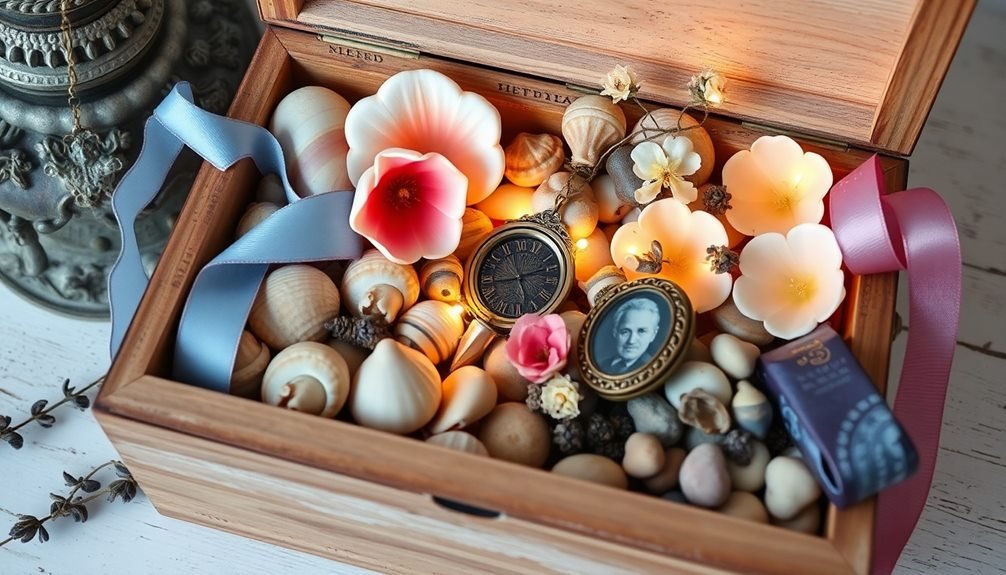
Throughout the year, thrift stores overflow with decorative boxes perfect for creating personalized anxiety relief tools. You'll find wooden boxes, vintage tins, and small chests that can be transformed into powerful anxiety management centers.
With some paint, fabric, and imagination, you can craft a dedicated space for your most cherished calming objects. Start by cleaning your chosen box thoroughly and decorating its exterior with colors or patterns that instantly soothe you.
The interior should be divided into sections using small containers, fabric-covered cardboard, or recycled gift boxes. This organization helps you quickly access specific items when anxiety strikes.
Fill your memory box with carefully chosen items that ground you during anxious moments:
- Sensory comforts: Include a soft fabric swatch, smooth stones, or stress balls for tactile relief
- Personal mementos: Add photos of happy moments, encouraging notes, or small trinkets that remind you of strength
- Calming tools: Store essential oils, a small journal, worry stones, or breathing exercise cards
Keep your memory box in an easily accessible spot, and make it a practice to open it whenever you feel overwhelmed or need emotional support.
Frequently Asked Questions
How Can Thrift Store Crafting Help Reduce Medication Dependence for Anxiety?
While crafting may help manage anxiety symptoms, you shouldn't use it to replace prescribed medications. Instead, use thrifting and creative projects alongside your treatment plan to provide additional stress relief and mindful focus.
What Safety Precautions Should I Take When Crafting With Previously Owned Items?
You'll need to clean items thoroughly with disinfectant before use. Always wear protective gloves, work in ventilated spaces, and check for sharp edges or hazardous materials. Don't skip washing fabric items first.
Can Therapeutic Crafting Trigger Anxiety in Some Individuals?
Yes, crafting can trigger anxiety if you're feeling pressured to achieve perfection or worried about making mistakes. It's best to set manageable goals, take breaks when needed, and remind yourself it's about the process.
Are There Specific Thrift Stores That Specialize in Craft-Suitable Items?
You'll find dedicated craft sections at Goodwill and Salvation Army stores. Some ReStore locations and local thrift shops specialize in craft supplies, fabrics, and DIY materials. Check your area's secondhand craft boutiques.
How Long Should Each Therapeutic Crafting Session Last for Maximum Benefit?
You'll want to craft for 30-45 minutes per session to avoid burnout. Listen to your body and energy levels – if you're feeling refreshed and focused, you can extend your creative time accordingly.
In Summary
You've discovered how secondhand treasures can become powerful tools for managing anxiety through mindful creativity. By transforming these thrift store finds into personal wellness objects, you're not just saving money – you're crafting meaningful solutions for emotional wellbeing. Whether you're painting furniture or arranging mosaics, these therapeutic projects help quiet your mind while giving pre-loved items new purpose in your mental health journey.

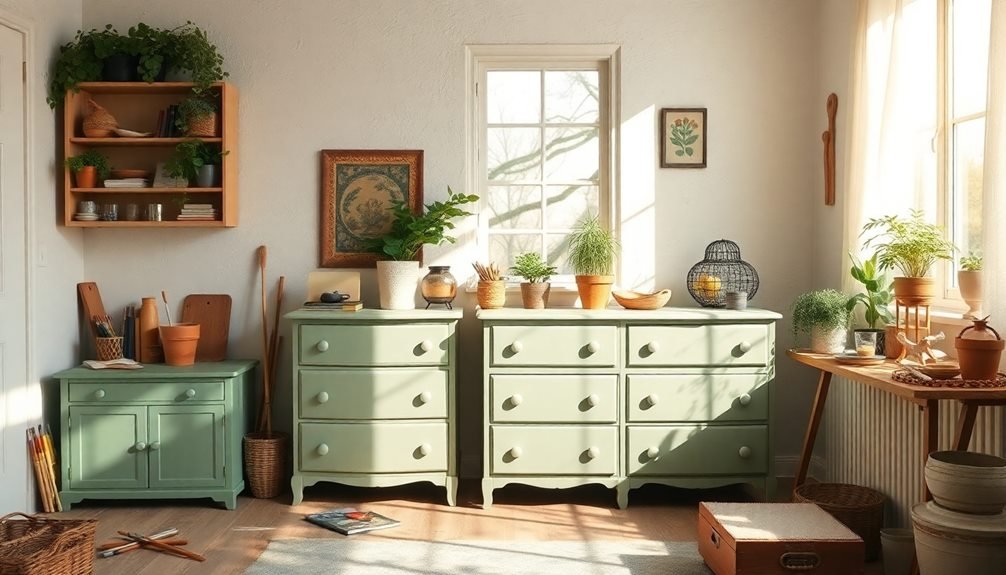
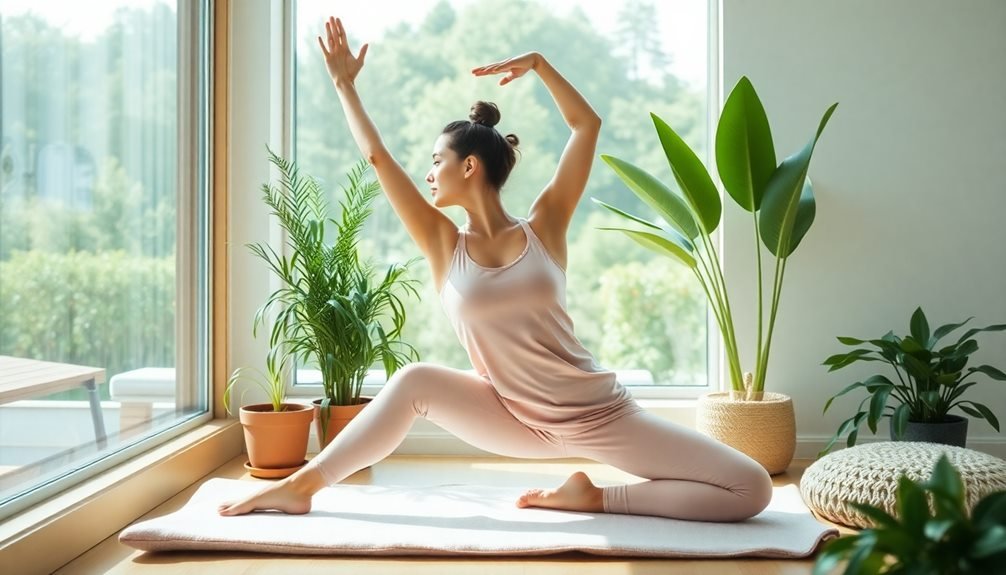
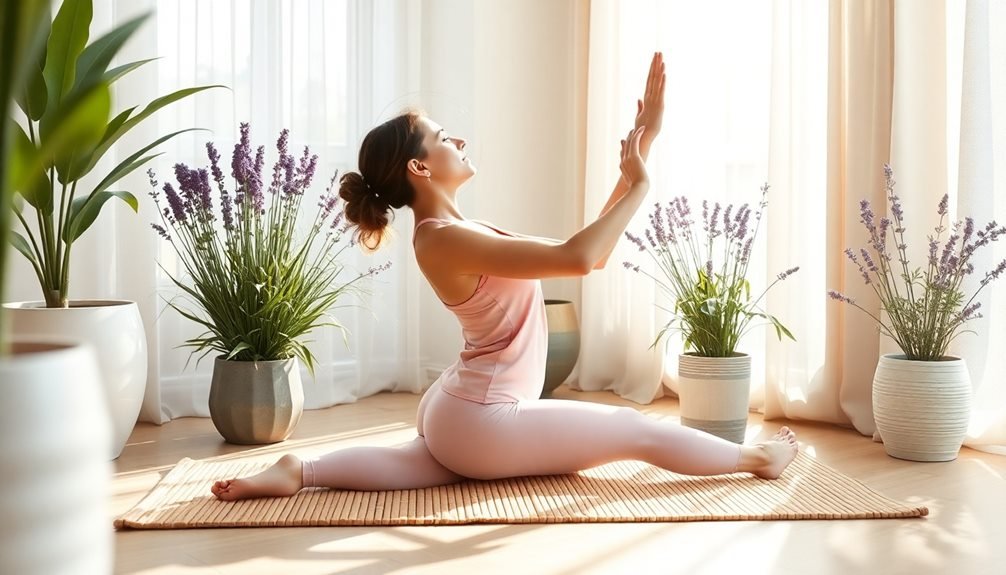
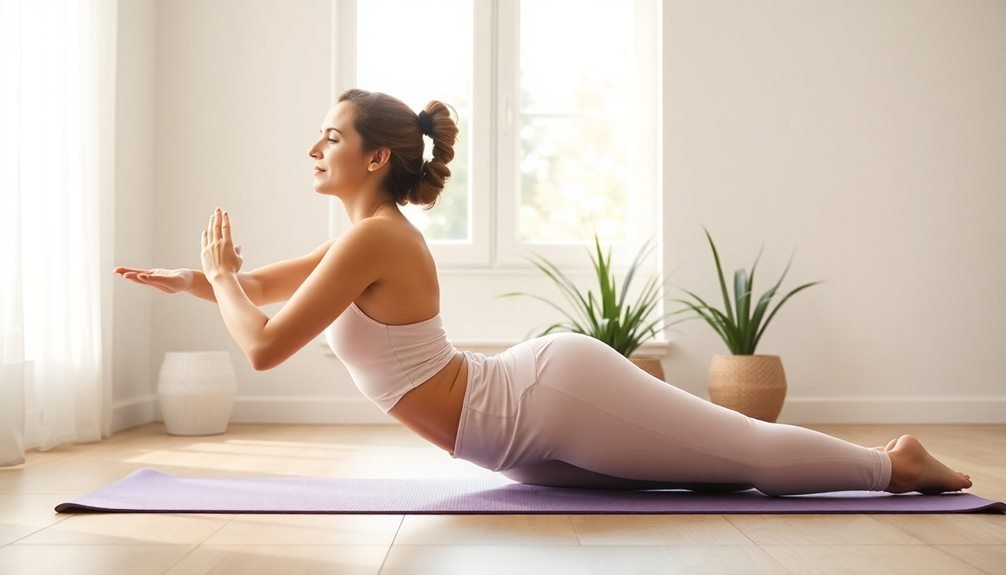
Leave a Reply